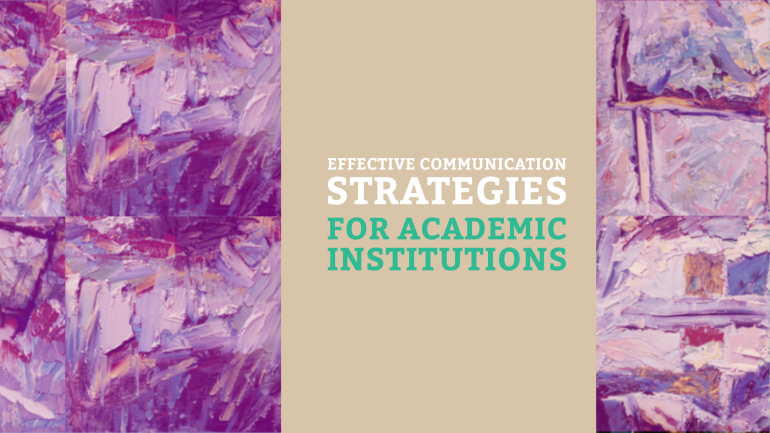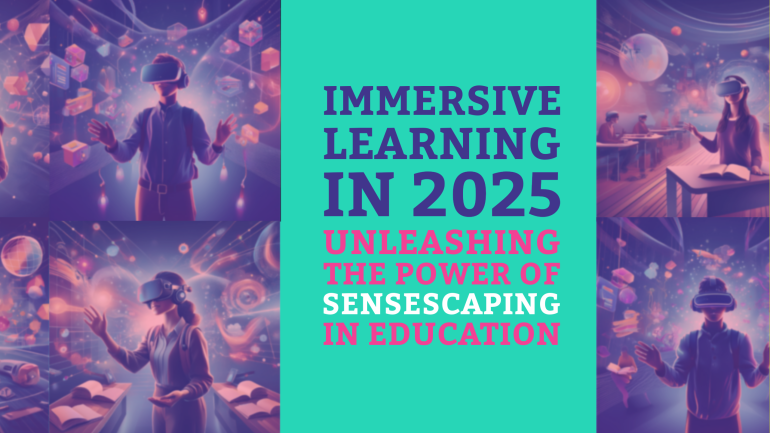This website uses cookies so that we can provide you with the best user experience possible. Cookie information is stored in your browser and performs functions such as recognising you when you return to our website and helping our team to understand which sections of the website you find most interesting and useful.
Table of Contents
TL;DR: Boosting Academic Success with Effective Communication Strategies
- Establish Clear Objectives: Define the purpose of communication within the academic institution to ensure clarity and effectiveness.
- Utilize Multiple Communication Channels: Use a variety of platforms such as emails, newsletters, social media, and in-person meetings to reach a diverse audience.
- Provide Timely and Relevant Information: Keep stakeholders informed about important updates, events, and changes in a timely manner to maintain engagement and transparency.
- Encourage Two-Way Communication: Foster open dialogue and feedback mechanisms to encourage collaboration and a sense of community within the institution.
- Train Staff and Faculty on Communication Skills: Invest in professional development programs to enhance communication skills among staff and faculty members, ultimately improving overall communication within the institution.
It’s crucial for academic institutions to have effective communication strategies in place to ensure that important information is conveyed clearly and efficiently. Clear communication helps to prevent misunderstandings, improves student engagement, and fosters a positive academic environment. In this blog post, we will discuss some key communication strategies that academic institutions can implement to enhance overall communication within the community.
Communication Frameworks for Academic Institutions
Integrated Marketing Communication (IMC) in Education
Any academic institution looking to enhance its communication strategies should consider adopting an Integrated Marketing Communication (IMC) approach. This holistic method emphasizes the importance of creating a seamless and consistent messaging across various channels to reach target audiences effectively. By integrating different communication tools such as advertising, public relations, social media, and direct marketing, academic institutions can create a strong brand presence and connect with students, parents, and other stakeholders in a meaningful way.
The Role of Strategic Communication Planning
An vital component of effective communication strategies for academic institutions is strategic communication planning. This involves developing a detailed roadmap outlining the institution’s communication goals, target audiences, key messages, and communication channels. By proactively planning and coordinating communication efforts, academic institutions can enhance their reputation, increase engagement, and build strong relationships with their stakeholders.
Role: Strategic communication planning plays a crucial role in aligning an academic institution’s communication efforts with its overall goals and objectives. By identifying key messages and strategically planning communication activities, institutions can effectively manage their reputation and address potential challenges in a proactive manner.
Internal Communication Strategies
Enhancing Faculty and Staff Engagement
The key to effective internal communication within academic institutions is to ensure high levels of engagement among faculty and staff. It is necessary to foster a culture of open communication, transparency, and collaboration. Regular meetings, email updates, and feedback mechanisms can help in keeping the faculty and staff informed and engaged with the institution’s goals and objectives. By involving faculty and staff in decision-making processes and seeking their feedback, institutions can create a sense of ownership and commitment among employees.
Student-Centered Communication Approaches
Enhancing student-centered communication approaches is crucial for academic institutions to foster a positive learning environment. Students are at the core of the academic community, and their needs and expectations should be a priority in communication strategies. Institutions can utilize various channels such as social media, newsletters, and student forums to engage with students effectively. Creating interactive platforms where students can provide feedback and suggestions can help in improving overall communication and student satisfaction.
Understanding the diverse needs and preferences of students is necessary in developing tailored communication strategies. By personalizing communication and providing relevant information, academic institutions can enhance student engagement and build a strong sense of community within the campus.
Communication Channels within Academic Communities
Internal communication channels play a critical role in connecting members within academic communities. An effective communication strategy should include a mix of traditional channels such as emails, newsletters, and notice boards, along with modern digital platforms like intranet portals and mobile applications. Providing multiple channels for communication ensures that information reaches all members of the academic community in a timely manner.
External Communication Strategies
Building Academic Brand and Reputation
For academic institutions, building a strong brand and reputation is crucial in attracting top students, faculty, and funding. External communication plays a vital role in shaping how the institution is perceived by stakeholders. By showcasing achievements, research breakthroughs, and community engagement initiatives through various channels such as social media, press releases, and events, academic institutions can enhance their brand image and credibility.
Engaging with Prospective Students and Parents
External communication strategies aimed at engaging with prospective students and parents are imperative for showcasing the value and opportunities offered by the academic institution. Open houses, campus tours, information sessions, and interactive websites are effective tools for providing insights into the campus culture, academic programs, and extracurricular activities. By maintaining active communication through personalized emails, social media campaigns, and virtual events, institutions can establish a connection with potential students and their families.
External engagement with prospective students and parents is a continuous process that requires a personalized approach to address their concerns, provide relevant information, and offer support throughout the application and enrollment process.
Alumni Relations and Outreach
The relationship between academic institutions and their alumni is crucial for long-term success and sustainability. By nurturing strong alumni relations through networking events, mentorship programs, newsletters, and recognition initiatives, institutions can foster a sense of loyalty and pride among graduates. Alumni outreach efforts not only help in fundraising and recruitment but also contribute to building a supportive community of professionals that can benefit current students and faculty.
The alumni network is a valuable resource that can provide insights into industry trends, career opportunities, and potential partnerships that can benefit the academic institution.
Collaboration with Industry and Partners
Collaboration with industry partners is imperative for academic institutions to stay relevant, innovative, and competitive in a rapidly evolving landscape. By establishing strategic partnerships with industry leaders, research institutions, and government agencies, academic institutions can leverage resources, expertise, and funding to support cutting-edge research, internship opportunities, and collaborative projects.
Understanding the needs and priorities of industry partners is key to developing mutually beneficial collaborations that drive innovation, knowledge transfer, and societal impact.
Digital Communication in Academia
Leveraging Social Media for Academic Purposes
Keep up with the fast-paced digital world by utilizing social media platforms to enhance academic communication. Social media channels such as Twitter, Facebook, and LinkedIn provide academic institutions with an opportunity to engage with students, faculty, and the community in real-time. By sharing educational content, news, and events, institutions can increase visibility and reach a wider audience.
Using Websites and Blogs for School Visibility
School websites and blogs are crucial tools for enhancing school visibility. These platforms serve as a hub for information about programs, faculty, research, and events. By ensuring that the website is continuously updated with relevant content, schools can showcase their achievements and offerings to prospective students and partners.
School blogs can serve as a platform for in-depth discussions on academic topics, research findings, and industry trends. They offer a more personal and informal way to engage with the audience, fostering a sense of community and transparency within the school.
The Impact of E-Learning on Academic Communication
One of the key impacts of e-learning on academic communication is the ability to reach a wider audience beyond physical boundaries. E-learning platforms enable institutions to offer courses and programs online, opening up opportunities for students around the globe to access quality education.
For instance, the flexibility of e-learning allows working professionals to pursue further education without compromising their careers. The interactive nature of online courses also promotes collaboration and discussion among students and instructors, enhancing the overall learning experience.
Crisis Communication and Management
Developing an Effective Crisis Communication Plan
For academic institutions, having an effective crisis communication plan in place is crucial to navigate through challenging times with transparency and efficiency. An institution must identify potential crisis scenarios, establish a clear chain of command, and designate spokespersons authorized to communicate with various stakeholders. This plan should also include protocols for timely information dissemination, media relations, and monitoring of social and traditional media channels.
Case Handling and Response Strategies
Handling a crisis effectively requires a structured approach that focuses on swift response, transparency, and empathy. Academic institutions must be prepared to address the crisis promptly, provide accurate information to stakeholders, and demonstrate a commitment to resolving the issue. To mitigate the impact of a crisis, institutions should have predefined response strategies, including message templates, communication channels, and training for staff members on how to handle inquiries and public statements.
To ensure a comprehensive approach to case handling and response strategies, institutions should also conduct regular drills and simulations to test the effectiveness of their communication protocols. By practicing different crisis scenarios, academic leaders can identify areas for improvement and refine their strategies to be better prepared for any unforeseen events.
The Role of Leadership in Managing Communication During Crises
To effectively manage communication during crises, academic leaders must demonstrate strong leadership qualities, including decisiveness, transparency, and empathy. Leaders play a critical role in setting the tone for how the institution responds to crises, reassuring stakeholders, and guiding the overall communication strategy. Crisis situations often require swift decision-making and clear communication, which can help maintain trust and credibility with the institution’s community and the public.
Crisis situations can test the leadership capabilities of academic institutions, but with a well-prepared crisis communication plan, effective case handling strategies, and strong leadership, institutions can navigate through challenges and emerge stronger on the other side. It is crucial for academic leaders to prioritize effective communication strategies during crises to uphold the reputation and integrity of the institution.
Measuring the Effectiveness of Communication Strategies
Despite the implementation of various communication strategies in academic institutions, it is crucial to measure their effectiveness to ensure they are achieving their intended outcomes. This chapter explores different methods to assess the impact of communication strategies and make necessary adjustments for improvement.
Key Performance Indicators (KPIs) for Academic Communications
With the vast amount of information shared within academic institutions, it is crucial to identify the key performance indicators (KPIs) that will help gauge the success of communication strategies. KPIs such as website traffic, social media engagement, email open rates, and event attendance can provide valuable insights into the reach and effectiveness of communication efforts.
Student and Staff Feedback Systems
Academic institutions should establish comprehensive student and staff feedback systems to gather insights on the effectiveness of communication strategies. By collecting feedback through surveys, focus groups, and one-on-one interactions, institutions can understand the preferences and needs of their audience, allowing for more targeted and impactful communication efforts.
Academic institutions must ensure that feedback mechanisms are easily accessible and promote a culture of open communication. This feedback loop is crucial for understanding the diverse perspectives within the institution and continuously improving communication strategies.
Continuous Improvement and Adaptation
Measuring the effectiveness of communication strategies is an ongoing process that requires continuous improvement and adaptation. By analyzing data from KPIs, feedback systems, and other metrics, institutions can identify areas for enhancement and refine their communication strategies accordingly.
Communications teams should be prepared to make swift adjustments based on feedback and evolving communication trends to ensure that messages are reaching the intended recipients in the most effective manner. Flexibility and agility are key components of successful communication strategies in academic institutions.
Training and Professional Development
Communication Skills Workshops for Educators
Training educators in communication skills is vital for effective teaching and collaboration within academic institutions. Communication skills workshops for educators can cover various topics such as active listening, verbal and nonverbal communication, conflict resolution, and feedback delivery. These workshops provide educators with the necessary tools to communicate clearly and effectively with students, colleagues, and other stakeholders.
Leadership Communication Training for Academic Leaders
Communication is paramount for academic leaders as they play a crucial role in setting the vision and direction of the institution. Leadership communication training for academic leaders focuses on enhancing their ability to communicate strategic goals, inspire their teams, and navigate complex situations. This training equips academic leaders with strong communication skills to foster a positive and productive working environment.
Professional development in leadership communication for academic leaders can lead to improved decision-making, increased collaboration, and enhanced relationships with stakeholders. By investing in leadership communication training, academic institutions can cultivate a culture of effective communication and drive success in both academic and administrative endeavors.
Final Words
Now, with the increasing importance of effective communication in academic institutions, it is imperative for leaders to implement strategies that facilitate clear and open channels of communication. By fostering a culture of transparency, active listening, and feedback, academic institutions can improve collaboration, build trust, and enhance overall academic success.
It is imperative for leaders to prioritize communication skills training for both faculty and students to ensure that everyone is equipped with the tools necessary to navigate complex academic environments. By recognizing the value of effective communication, academic institutions can create a conducive learning environment where ideas are shared, problems are solved, and relationships are strengthened.
FAQ
Q: What are Effective Communication Strategies for Academic Institutions?
A: Effective communication strategies for academic institutions involve clear, timely, and concise messaging to students, faculty, staff, and parents. This may include utilizing various communication channels such as email, social media, websites, and newsletters.
Q: Why are Effective Communication Strategies important for Academic Institutions?
A: Effective communication strategies are crucial for academic institutions to ensure that important information is disseminated efficiently, maintain transparency, build trust, and foster a strong sense of community among stakeholders.
Q: How can Academic Institutions improve Communication with Students?
A: Academic institutions can improve communication with students by implementing student portals for centralized information, sending regular updates via email and text messages, conducting surveys to gather feedback, and organizing town hall meetings or forums.
Q: What role does Social Media play in Communication for Academic Institutions?
A: Social media plays a significant role in communication for academic institutions by allowing real-time updates, engaging with the community, sharing important news and events, showcasing achievements, and providing a platform for feedback and discussions.
Q: How can Academic Institutions ensure Effective Communication during Crises?
A: Academic institutions can ensure effective communication during crises by developing a crisis communication plan, establishing communication protocols, having designated spokespeople, providing regular updates, addressing concerns proactively, and utilizing multiple communication channels to reach all stakeholders.





